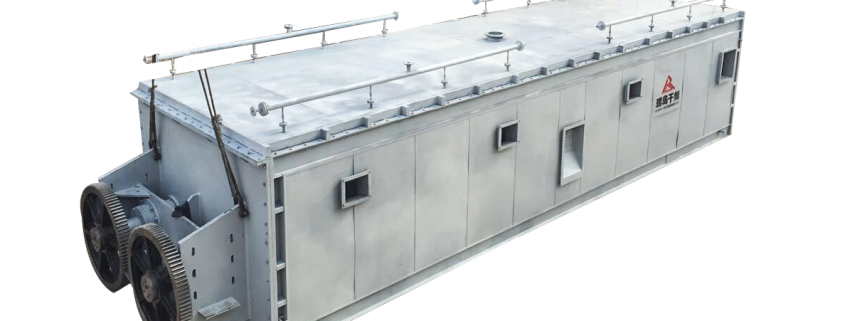Polyvinyl alcohol (PVA) is an important organic chemical raw material widely used in the fields of emulsions, coatings, adhesives and fiber auxiliaries. Polyvinyl alcohol drying is the last key step in the product and directly affects product quality. The main volatiles of polyvinyl alcohol are methanol and acetic acid, which are flammable, explosive and toxic substances. They have high requirements on drying safety, and the product grades are up to 30 kinds. The physical properties of various grades are large, dry. It is easy to agglomerate and stick to the wall. After investigation and research, it was decided to adopt a two-stage drying process of polyvinyl alcohol hollow blade, which was ideal after use.
Drying status and problems of polyvinyl alcohol
The rake dryer is commonly used in the conventional drying process of polyvinyl alcohol, and the following problems mainly exist:
The dryer is bulky and has low heat transfer efficiency. The domestic dry type of polyvinyl alcohol with a dry treatment capacity of 1 t / h is 2.8 m in diameter and 25 to 30 m in length. The dryer only transfers heat by the wall of the clamp sleeve, the inner wall has a thickness of 20 mm, the heat transfer coefficient is small, and the heat transfer effect is poor, especially after the inner wall is bonded, the heat transfer efficiency is lower.
There is a dry corner and a sticky wall. A dry dead zone is formed at the temperature measurement point inside the dryer, the bearing seat and the end plate where the tweezers cannot be scraped. In addition, due to the long barrel of the equipment, the concentricity of the cylinder is not guaranteed, the gap between the rafter and the wall of the cylinder is not uniform (10-20 mm), some materials cannot be scraped, and the long-term operation will be crusted and adhered to the wall. Usually, it is necessary to clean the internal leather material after running for more than one month, otherwise the yellow dot material will be mixed in the product, which will affect the product quality.
It is difficult to clean up and the failure rate is high. The tweezers and bearing blocks in the dryer affect the person to clean inside. Each cleaning needs to stop for a day or so, and the temperature and temperature rise are also slow, resulting in longer parking time, which directly affects the output of the product. The tweezers of the dryer are connected to the shaft by the connecting arm. The connecting bolts are often loosened by the vibration of the running vibration and the temperature, and the tweezers will scrape the wall, causing the bending of the tweezers and the connecting arms, and must be stopped at this time.
The two internal bearings cannot be refueled during operation. The bearings are short of oil during operation and the bearings are damaged frequently. The main shaft of the bearing is generally divided into three sections and three sections. The small section of the solid shaft and the large section of the hollow shaft are connected by flat keys. When the scraping wall and the tweezer are damaged, the flat key is often overloaded, and the shearing damage of the key occurs. Frequent opening and closing has a great impact on continuous production, which not only causes the increase of material consumption, but also increases the probability of occurrence of non-conforming products and the increase of by-products, which brings difficulty and trouble to the process operation, and ultimately affects the quality of polyvinyl alcohol products.
Two-stage drying technology process of polyvinyl alcohol hollow blade
The wet polyvinyl alcohol granules from the press are mixed with the dry polyvinyl alcohol granules from the external returning system into the primary paddle dryer. The dryer hot shaft and the paddle blades are hollow, the inside is steamed, and the material is along with the hot axis. The rotation gradually moves toward the discharge end while receiving the heat transferred from the hot shaft and the blade, the temperature of the material rises, and the moisture is vaporized. The primary dryer is the main drying unit for the drying of polyvinyl alcohol, which accounts for 70% of the total dryness.
After the first stage drying, the material enters the second-stage drying, and the moisture in the material continues to evaporate through the indirect heat transfer between the hot shaft and the blade. Finally, after the drying is passed, the dryer overflows and exits the drying system to enter the vibrating screen. Large particles and agglomerated products are discharged from the waste port. Most of the dry particles of polyvinyl alcohol that meet the requirements are discharged for packaging, and some of the qualified products are returned to the drying system through the return system. The volatilization of the second-stage dry evaporation enters the first-stage dryer through the feed port of the first-stage dryer, mixes with the first-stage dried volatiles, and then draws out from the first-stage dryer into the condensation by the negative pressure generated by the decompression and suction system. recycling system.
Paddle dryer structure
The main equipment in the polyvinyl alcohol drying process system is a paddle dryer, which is a heat conduction type drying device, which is composed of a hot shaft, a fuselage, an end plate, an upper cover and a transmission system. The heat exchange surface of the dryer is mainly two hot shafts, wedge-shaped blades and a casing with honeycomb jacket. The wedge-shaped blades on the hot shaft are the main heating surface, and the heat exchange area accounts for more than 70% of the total heat exchange area.



